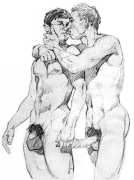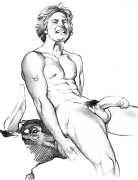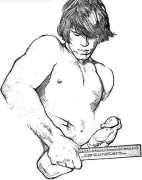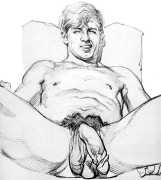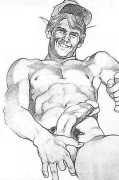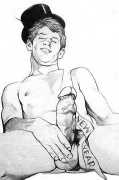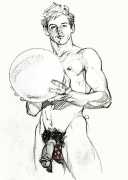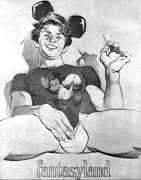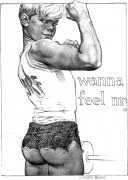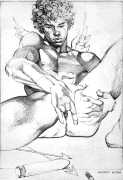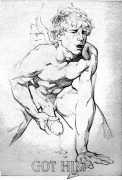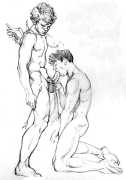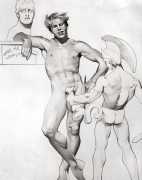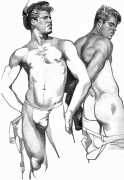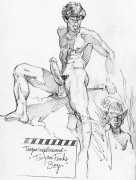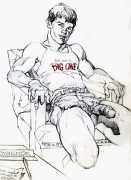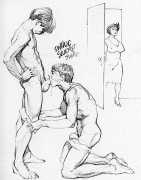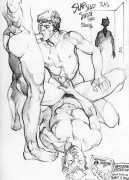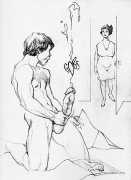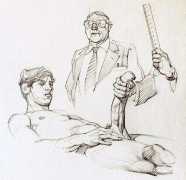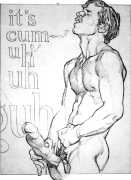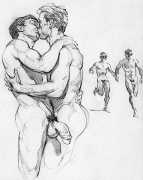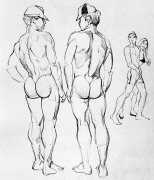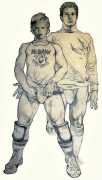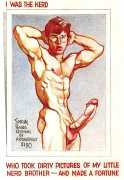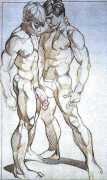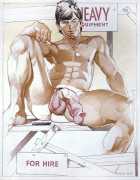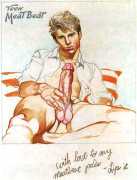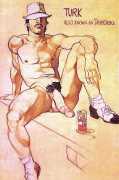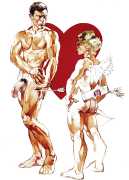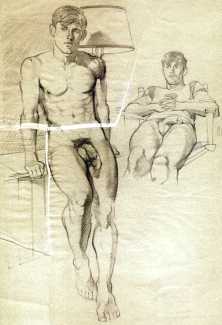
Harry Bush, best known for his detailed and brilliantly observed gay drawings, was a late developer as an artist, and it is remarkable that he was self-trained, having only taken only one community college drawing class in his early twenties.
For nearly two decades Bush served in the United States Navy and United States Air Force; he had his first homosexual experiences while deployed in the European theatre. After the war he worked at the Pentagon until the early 1960s, retiring from military service on health grounds at the age of forty and relocating to Los Angeles, close to where he had grown up. He had taken up illustration as a pastime during the war, and back in California lingered around the fringes of the gay community there, making drawings from life as a pastime.
In the 1960s a number of gay American artists gathered around magazines like Bodybuilding, which featured pictures of men in more or less erotic contexts. For years the Bodybuilding space was the excuse for anyone who wanted to reach out to the gay community without risking legal trouble; the style and content of works like Harry Bush’s were limited by US censorship codes, which prohibited depictions of ‘obvious homosexual acts’. It was only in 1962 that the Supreme Court decriminalised male nudity, ruling that a nude male photograph was not obscene.
In 1965 Bush’s artwork was discovered by Bob Mizer, the founder of the Athletic Model Guild. In January 1966 Mizer published Bush’s work for the first time in the beefcake magazine Physique Pictorial, making Bush only the second artist after George Quaintance to be featured in the magazine. In the following years works by Bush were published in Mr Sun, In Touch, Stroke, and Drummer.

His materials were simple. He worked mostly in graphite and coloured pencils, and occasionally in paint, ink and watercolour. Bush worked on his designs persistently, sometimes for weeks or even months, in order to be able to translate his fantasies into some kind of reality.
Why then is Harry Bush’s work not better known? The collaboration of Touko Laaksonen, better known as Tom of Finland, with Physique Pictorial magazine is well-known, yet few people remember Bush. The simple fact is that while Tom of Finland used the magazines of the 1960s as a springboard for the following decades, Bush did not. The sad reality is that behind those extraordinary designs, so vital, sunny and happy which the smiling boys presented, Bush was an sad and troubled soul. He was notoriously reclusive, and critical of what he perceived as the superficiality of the gay community. His isolation, combined with fears of copyright infringement, led him to destroy much of his original artwork. He remained closeted for the majority of his life due to a persistent fear that he would be outed and lose his veteran’s pension. Despite this, however, he never worked under a pseudonym and signed all of his art with his own name.
The result was that Bush lived something of a double life. He hid his work from his large family, who never suspected or knew about his work and his reputation during the artist’s lifetime. Even after his death Bush made sure that no trace of his work was found in his apartment, destroying a large number of designs and asking his friend Robert Mainardi, when he was hospitalised with the heart emphysema he was to die of, to go into his locked office and remove anything relevant. ‘I don’t want no money for any of this bullshit, Bob. I just want to get rid of them,’ he said. Thus the great secret of his life remained well hidden.
We are very grateful to our Russian friend Yuri for suggesting the inclusion of this artist, and for supplying most of the images.

